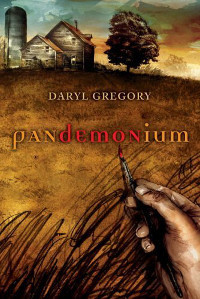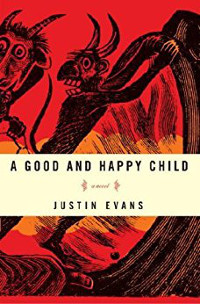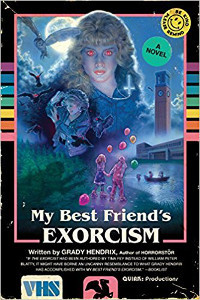That changed recently. First, I read A Head Full of Ghosts by Paul Tremblay, a clever novel that pays homage to numerous horror novels and movies about demonic possession, including The Exorcist. The book sent me on a month-long binge of demonic possession books, including the grandaddy of them all.
A Head Full of Ghosts by Paul Tremblay A literary novel about demonic possession of a teenage girl in Massachusetts that’s also about a lot of other things: reality television, social media, greed, and faith, to name a few. And the possession is always carefully left in doubt. Is it real or fake? The story concerns a young woman recounting the story of her sister’s exorcism on a reality TV show when she was eight and her sister was fourteen. There are so many things to enjoy about this book: the unreliable narrator, the different writing styles, the skewering of reality television and pop culture criticism, the numerous references to other classic horror novels and movies (including The Exorcist). It’s a coy but controlled performance. Tremblay never shows his cards, and he masterfully folds the story in on itself, twisting the narrative in interesting ways. The conclusion is a shocker. The book won the 2015 Bram Stoker Award for best novel.
A Head Full of Ghosts
Paul Tremblay
William Morrow
Come Closer
by Sara Gran
A literary novel about demonic possession of a teenage girl in Massachusetts that’s also about a lot of other things: reality television, social media, greed, and faith, to name a few. And the possession is always carefully left in doubt. Is it real or fake? The story concerns a young woman recounting the story of her sister’s exorcism on a reality TV show when she was eight and her sister was fourteen. There are so many things to enjoy about this book: the unreliable narrator, the different writing styles, the skewering of reality television and pop culture criticism, the numerous references to other classic horror novels and movies (including The Exorcist). It’s a coy but controlled performance. Tremblay never shows his cards, and he masterfully folds the story in on itself, twisting the narrative in interesting ways. The conclusion is a shocker. The book won the 2015 Bram Stoker Award for best novel.
A Head Full of Ghosts
Paul Tremblay
William Morrow
Come Closer
by Sara Gran
 A young woman named Amanda, an architect, gradually falls to pieces as a demon named Naamah takes control of her life. If you want surprises, look elsewhere (such as Tremblay’s book). The narrator, Amanda, is uninteresting and passive. So is her husband Ed, an accountant. Is the story set in New York? Chicago? Cleveland? No idea. Gran provides no sense of place. It could be any city (except one on the West Coast, since Amanda spends two days there on business). Gran handles the escalating horror reasonably well, but she doesn’t provide any emotional depth to Amanda, so we never care about her shocking decline. Consequently, the book is dreary and predictable. To make things worse, Gran made me uncomfortable on page 3 when her shallow narrator made a casual homophobic remark. She did it again eighty pages later. Not sure what homophobia has to do with demons. Great cover, though.
Come Closer
Sara Gran
Soho Press
Pandemonium
by Daryl Gregory
A young woman named Amanda, an architect, gradually falls to pieces as a demon named Naamah takes control of her life. If you want surprises, look elsewhere (such as Tremblay’s book). The narrator, Amanda, is uninteresting and passive. So is her husband Ed, an accountant. Is the story set in New York? Chicago? Cleveland? No idea. Gran provides no sense of place. It could be any city (except one on the West Coast, since Amanda spends two days there on business). Gran handles the escalating horror reasonably well, but she doesn’t provide any emotional depth to Amanda, so we never care about her shocking decline. Consequently, the book is dreary and predictable. To make things worse, Gran made me uncomfortable on page 3 when her shallow narrator made a casual homophobic remark. She did it again eighty pages later. Not sure what homophobia has to do with demons. Great cover, though.
Come Closer
Sara Gran
Soho Press
Pandemonium
by Daryl Gregory
 In Gregory’s debut novel, widespread demonic possession, which started in the 1940s, has reached epidemic proportions, and demons routinely switch from one body to another. The demons have different characteristics. The demon who has possessed Del Pierce, a graphic artist, since age 5 is called Hellion because it is a mischief-maker. Gregory handles this fascinating premise with deft sophistication, intelligence, and sardonic wit. The book is a pop culture mashup that mixes in Philip K. Dick, Lovecraft, an exorcist based on Sinead O’Connor, O.J. Simpson, Nixon, A. E. van Vogt, Jung, comic books, a swamp monster, and a throng of demon convention fans. It’s a whimsical concoction, a rich alternate universe. Gregory does some clever world building in several demonology chapters that focus on the different demon personas and their run-ins with historical people; each of these chapters reads like a standalone story. Gregory is an excellent writer, adept at dialogue, characterization, and vivid imagery. The book’s realistic take on comic book characters reminded me of M. Night Shyamalan’s movie Unbreakable. The conclusion is shocking and emotionally satisfying. Great debut from a talented, intelligent author.
Pandemonium
Daryl Gregory
Del Rey
A Good and Happy Child
by Justin Evans
In Gregory’s debut novel, widespread demonic possession, which started in the 1940s, has reached epidemic proportions, and demons routinely switch from one body to another. The demons have different characteristics. The demon who has possessed Del Pierce, a graphic artist, since age 5 is called Hellion because it is a mischief-maker. Gregory handles this fascinating premise with deft sophistication, intelligence, and sardonic wit. The book is a pop culture mashup that mixes in Philip K. Dick, Lovecraft, an exorcist based on Sinead O’Connor, O.J. Simpson, Nixon, A. E. van Vogt, Jung, comic books, a swamp monster, and a throng of demon convention fans. It’s a whimsical concoction, a rich alternate universe. Gregory does some clever world building in several demonology chapters that focus on the different demon personas and their run-ins with historical people; each of these chapters reads like a standalone story. Gregory is an excellent writer, adept at dialogue, characterization, and vivid imagery. The book’s realistic take on comic book characters reminded me of M. Night Shyamalan’s movie Unbreakable. The conclusion is shocking and emotionally satisfying. Great debut from a talented, intelligent author.
Pandemonium
Daryl Gregory
Del Rey
A Good and Happy Child
by Justin Evans
 The start of this thriller is so good that it’s a shock how uninteresting, clumsy, and unconvincing the rest of the book is. I rarely give up on a book, but it took all my will to finish this one. At the start, new parent George Davies is terrified of holding his infant son, so he sees a therapist to help with his anxiety. He tells the therapist that he saw another therapist for depression when he was 11, so the man provides him spiral notebooks to write down what happened to him when he was younger. The notebooks provide the meat of the narrative for the book, an extended flashback of George’s troubling childhood. Evans plays an oscillating game with the book: Is George possessed by a demon or is he mentally ill? The books shifts back and forth between the two possibilities. Turns out that George’s father, a Medievalist who died from malaria in Honduras when he was eleven, was also possessed by a demon, or so say his father’s friends, who repeatedly try to convince George that he’s inherited the same demon from his father. The eleven-year-old George, who is quite smart, seems completely unlike the adult George, who’s a blank page. There are attempted exorcisms in the book, but they’re subdued compared to climactic scenes in The Exorcist. It’s a pretentious psychological horror story that isn’t particularly scary or clever. The rushed ending is ambiguous. The book’s casual racism was a turnoff. Of the books reviewed here, this is my least favorite.
The start of this thriller is so good that it’s a shock how uninteresting, clumsy, and unconvincing the rest of the book is. I rarely give up on a book, but it took all my will to finish this one. At the start, new parent George Davies is terrified of holding his infant son, so he sees a therapist to help with his anxiety. He tells the therapist that he saw another therapist for depression when he was 11, so the man provides him spiral notebooks to write down what happened to him when he was younger. The notebooks provide the meat of the narrative for the book, an extended flashback of George’s troubling childhood. Evans plays an oscillating game with the book: Is George possessed by a demon or is he mentally ill? The books shifts back and forth between the two possibilities. Turns out that George’s father, a Medievalist who died from malaria in Honduras when he was eleven, was also possessed by a demon, or so say his father’s friends, who repeatedly try to convince George that he’s inherited the same demon from his father. The eleven-year-old George, who is quite smart, seems completely unlike the adult George, who’s a blank page. There are attempted exorcisms in the book, but they’re subdued compared to climactic scenes in The Exorcist. It’s a pretentious psychological horror story that isn’t particularly scary or clever. The rushed ending is ambiguous. The book’s casual racism was a turnoff. Of the books reviewed here, this is my least favorite.
 Graham Masterton, a former Penthouse editor and bestselling sex guide author (How to Drive Your Man Wild in Bed), improbably transitioned to the horror genre with his breakout novel The Manitou (1976), which became a hit movie. He went on to write more than 35 horror novels. Masterton’s proven horror formula is to transform folklore into fast-paced, gory pulp novels. Charnel House is about a San Francisco house that breathes. The owner complains of the strange phenomenon to John Hyatt of the Dept. of Sanitation (?), and Hyatt enlists a fellow engineer to check out the house. Turns out it’s possessed by an ancient demon called The First One to Use Words for Force, familiar to Navajo Indians as Coyote. The demon is awakened from its sleep by a magical talisman, and then demonic horror ensues. Unlike other books reviewed here, the characters accept these supernatural events without much question. Hyatt and a Native American shaman race to stop the demon from becoming incarnate and achieving ultimate power. The book features an everyman first-person narrator, rich Native American folklore, a truly frightening demon, a breathless pace, colorful Bay Area locations (including a climax at the Golden Gate Bridge), and goofy, lighthearted humor. Unlike most demonic possession stories, this demon actually has an objective, which heightens suspense. Unfortunately, the plot is simple and offers few twists. The book reads like a 90-minute, R-rated, gonzo B-horror movie. It’s not great literature, but it’s a lot of fun. The book was awarded a Special Edgar by Mystery Writers of America.
Charnel House
Graham Masterton
Open Road Media
My Best Friend’s Exorcism
by Grady Hendrix
Graham Masterton, a former Penthouse editor and bestselling sex guide author (How to Drive Your Man Wild in Bed), improbably transitioned to the horror genre with his breakout novel The Manitou (1976), which became a hit movie. He went on to write more than 35 horror novels. Masterton’s proven horror formula is to transform folklore into fast-paced, gory pulp novels. Charnel House is about a San Francisco house that breathes. The owner complains of the strange phenomenon to John Hyatt of the Dept. of Sanitation (?), and Hyatt enlists a fellow engineer to check out the house. Turns out it’s possessed by an ancient demon called The First One to Use Words for Force, familiar to Navajo Indians as Coyote. The demon is awakened from its sleep by a magical talisman, and then demonic horror ensues. Unlike other books reviewed here, the characters accept these supernatural events without much question. Hyatt and a Native American shaman race to stop the demon from becoming incarnate and achieving ultimate power. The book features an everyman first-person narrator, rich Native American folklore, a truly frightening demon, a breathless pace, colorful Bay Area locations (including a climax at the Golden Gate Bridge), and goofy, lighthearted humor. Unlike most demonic possession stories, this demon actually has an objective, which heightens suspense. Unfortunately, the plot is simple and offers few twists. The book reads like a 90-minute, R-rated, gonzo B-horror movie. It’s not great literature, but it’s a lot of fun. The book was awarded a Special Edgar by Mystery Writers of America.
Charnel House
Graham Masterton
Open Road Media
My Best Friend’s Exorcism
by Grady Hendrix
 The perfect book for a Gen Xer who loves campy teen horror movies. Hendrix has described the book as Beaches meets The Exorcist. It’s about two awkward teenage girls in 1988 Charleston, Abby Rivers and Gretchen Lang. One night, the two venture out to a cabin in the woods to skinny dip and drop acid with their girlfriends. Unfortunately, Gretchen returns from that evening dramatically changed. Initially, Abby suspects that Gretchen was raped, but a member of a Christian boy band later convinces her that Gretchen is instead possessed by a demon. The book nails the southern high school setting and the time period; it’s packed with pop-culture references (the chapter titles are Eighties song lyrics). It’s also a touching coming-of-age novel about friendship, insecurity, and teen angst. Demons are scary, but nothing’s scarier than losing your best friend. Hendrix has a flair for dark teenage comedy, like the Eighty’s movie Heathers. The over-the-top horror scenes in My Best Friend’s Exorcism are crafted exuberantly and in stomach-turning detail. Is Gretchen literally possessed? Hendrix cleverly leaves some ambiguity, providing a reasonable explanation that doesn’t completely rule out the demon. I felt such a deep connection with the characters Abby and Gretchen that the night after I finished the book I actually had a nightmare about them. My only disappointment was the final chapter, which provides a rushed summary of the remainder of Abby’s life. I didn’t need that, and it doesn’t make any sense since the first chapter flashes back from 2008. As a conventional frame, the final chapter should have returned to 2008, or shortly thereafter, not several decades later (to the 2050s!). Better to leave readers with hope for a sequel.
My Best Friend’s Exorcism
Grady Hendrix
Quirk Books
The Exorcist
The perfect book for a Gen Xer who loves campy teen horror movies. Hendrix has described the book as Beaches meets The Exorcist. It’s about two awkward teenage girls in 1988 Charleston, Abby Rivers and Gretchen Lang. One night, the two venture out to a cabin in the woods to skinny dip and drop acid with their girlfriends. Unfortunately, Gretchen returns from that evening dramatically changed. Initially, Abby suspects that Gretchen was raped, but a member of a Christian boy band later convinces her that Gretchen is instead possessed by a demon. The book nails the southern high school setting and the time period; it’s packed with pop-culture references (the chapter titles are Eighties song lyrics). It’s also a touching coming-of-age novel about friendship, insecurity, and teen angst. Demons are scary, but nothing’s scarier than losing your best friend. Hendrix has a flair for dark teenage comedy, like the Eighty’s movie Heathers. The over-the-top horror scenes in My Best Friend’s Exorcism are crafted exuberantly and in stomach-turning detail. Is Gretchen literally possessed? Hendrix cleverly leaves some ambiguity, providing a reasonable explanation that doesn’t completely rule out the demon. I felt such a deep connection with the characters Abby and Gretchen that the night after I finished the book I actually had a nightmare about them. My only disappointment was the final chapter, which provides a rushed summary of the remainder of Abby’s life. I didn’t need that, and it doesn’t make any sense since the first chapter flashes back from 2008. As a conventional frame, the final chapter should have returned to 2008, or shortly thereafter, not several decades later (to the 2050s!). Better to leave readers with hope for a sequel.
My Best Friend’s Exorcism
Grady Hendrix
Quirk Books
The Exorcist
by William Peter Blatty
 Here’s the book that started it all. After modest success as a comic novelist and screenwriter, Bill Blatty mined his Catholic faith and experiences at Jesuit schools (including Georgetown University) to craft the first and most sensational exorcism novel. Reading it today, the book also fits squarely within the genre of medical thriller, blazing a trail for authors Robin Cooke and Michael Palmer. It’s a cleverly crafted engine of horror, and other horror novelists can learn much from studying its structure and techniques. It holds up well after all these years. Blatty slowly builds tension and expertly ratchets up the pace as the book proceeds. The explicit profanity, shocking sexual content (masturbation with a crucifix!), and prurient details of occult rites make the book sleazy and offensive, but they also guaranteed the book would become a huge bestseller. The murder investigation by Lieutenant Klinderman of Chris MacNeil’s friend Burke Dennings slows the book down, but those scenes provide some welcome comic repartee between Klinderman and Karras. Without those scenes the book would be relentlessly dark and dreary. Father Merrin, the frail exorcist of the title, appears in a short prologue set in Iraq, where he’s participating in an archaeological dig, and he doesn’t appear again until 85% through the book. But the moment he arrives on the scene, the book rushes to a thrilling, heart-pounding conclusion. Is The Exorcist blasphemous and anti-Catholic, as many critics claimed upon its publication? No, Blatty would probably respond, it’s a book about a priest (Father Karras) who undergoes a crisis of faith but ultimately finds the strength to confront evil. I rarely enjoy reading a book after seeing the movie first, but The Exorcist was an exception. Father Karras is a more fully developed character in the book, which drew me into the story, despite my familiarity with the ending. It’s understandable why The Exorcist, Blatty’s magnum opus, sold 13 million copies. It’s a well-crafted potboiler that’s still provocative in many ways. Blatty died in January 2017 at the age of 89.
Here’s the book that started it all. After modest success as a comic novelist and screenwriter, Bill Blatty mined his Catholic faith and experiences at Jesuit schools (including Georgetown University) to craft the first and most sensational exorcism novel. Reading it today, the book also fits squarely within the genre of medical thriller, blazing a trail for authors Robin Cooke and Michael Palmer. It’s a cleverly crafted engine of horror, and other horror novelists can learn much from studying its structure and techniques. It holds up well after all these years. Blatty slowly builds tension and expertly ratchets up the pace as the book proceeds. The explicit profanity, shocking sexual content (masturbation with a crucifix!), and prurient details of occult rites make the book sleazy and offensive, but they also guaranteed the book would become a huge bestseller. The murder investigation by Lieutenant Klinderman of Chris MacNeil’s friend Burke Dennings slows the book down, but those scenes provide some welcome comic repartee between Klinderman and Karras. Without those scenes the book would be relentlessly dark and dreary. Father Merrin, the frail exorcist of the title, appears in a short prologue set in Iraq, where he’s participating in an archaeological dig, and he doesn’t appear again until 85% through the book. But the moment he arrives on the scene, the book rushes to a thrilling, heart-pounding conclusion. Is The Exorcist blasphemous and anti-Catholic, as many critics claimed upon its publication? No, Blatty would probably respond, it’s a book about a priest (Father Karras) who undergoes a crisis of faith but ultimately finds the strength to confront evil. I rarely enjoy reading a book after seeing the movie first, but The Exorcist was an exception. Father Karras is a more fully developed character in the book, which drew me into the story, despite my familiarity with the ending. It’s understandable why The Exorcist, Blatty’s magnum opus, sold 13 million copies. It’s a well-crafted potboiler that’s still provocative in many ways. Blatty died in January 2017 at the age of 89.
Share this:





